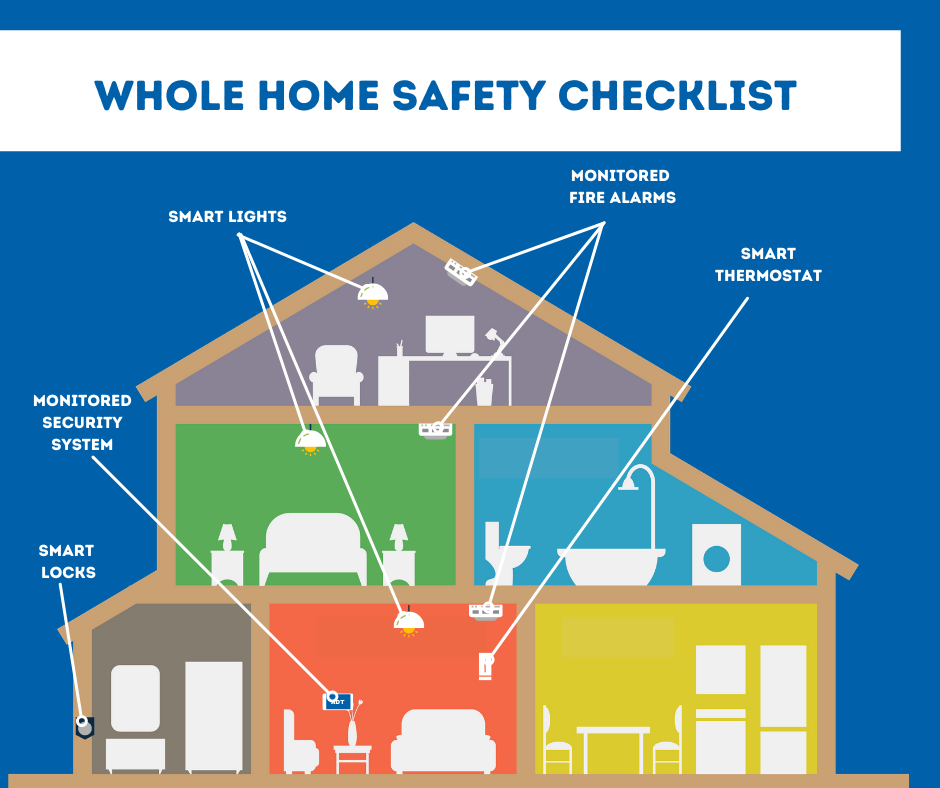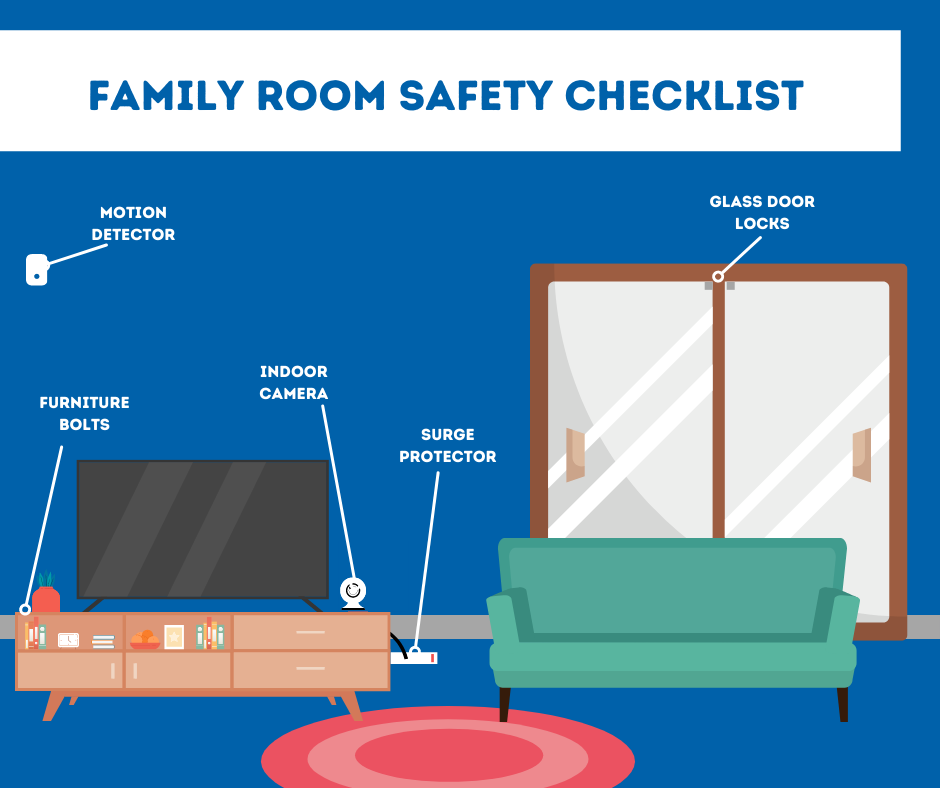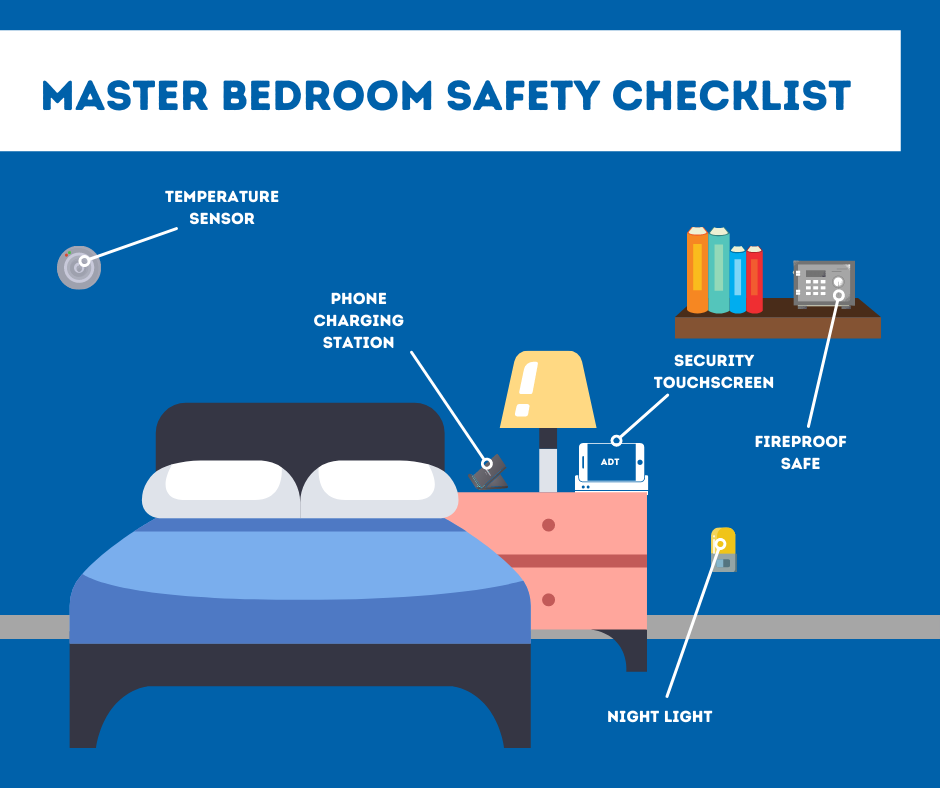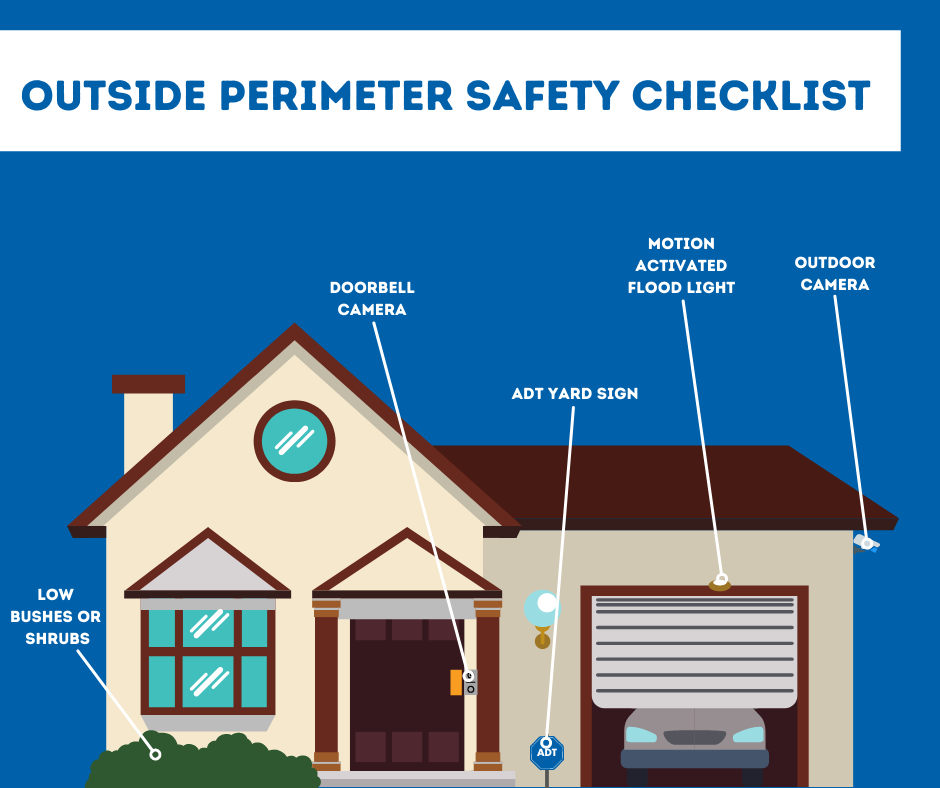Home Safety Checklist For Mobile
Keeping safe in your home should be your number one priority. But are you overlooking some key safety items? Take this home safety checklist for Mobile and find out where your living space requires some work.
This guide starts with some whole-house safety ideas, and then we whittle it down on a room level. Then, contact (251) 207-7344 or fill out the form below to speak to a security agent.

Whole Home Safety Checklist for Mobile
While you may want to take a individual room process for home safety in Mobile, there are a few items that work for the whole-house approach. These items can link to each other through a smart hub, and oftentimes respond to other components. You can also manage each of your home safety devices through a mobile security app, such as ADT Control:
-
Monitored Security System: Each one of your entryways should employ a sensor that warns your family to intrusion. When an alarm trips, your monitoring expert picks up the alert and immediately sends a first responder.
-
Smart Lights For Every Major Room: Of course, you can schedule your smart bulbs to become more eco-conscience. But they can also help you remain safe in an emergency. Have your lights come on when a sensor triggers to shoo off intruders or illuminate the way out to a safe area.
-
Smart Thermostat: Likewise, a smart thermostat in Mobile could save you between 10%-15% in gas and electric spending. Also, it can start an exhaust fan during a fire.
-
Monitored Fire Alarms: It’s code that you have a fire alarm on every level of your house. You can improve your fire preparedness by hanging a monitored fire alarm that looks for excessive heat and smoke, and pings your round-the-clock monitoring team when it thinks that there’s a fire.
-
Smart Locks: Every door that utilizes a keyed lock can upgrade to a smart lock. Now you can program codes to each family member and get notifications to your phone when your locks are activated. Your smart lock can even automatically turn off, helping you to quickly get out when you have a fire or dangerous situation.

Family Room Safety Checklist For Mobile
You’ll spend a lot of time in your living room, so it’s the most reasonable place to start your home safety renovation. Electronics, like your TV or video games, typically sit in your living room, making it a popular room for thieves. Start with installing a motion sensor or indoor security camera in there, then take a look at some of these safety protocols:
-
Motion Sensors: By installing motion sensors, you’ll get a high-decibel noise whenever they detect unusual motion within your living room. Look for motion sensors that filter out pets or you’ll get an alert each time your dog comes in for a bite of food.
-
Security Camera: An indoor security camera puts a constant watch on your family room. Watch real-time feeds of your room so you can see what’s downstairs through the mobile app. Or chat with family members in the room using the two-way talk feature.
-
Surge Protector/Outlet Maintenance: Protect all your electronics and quit overburdening your circuits with a surge protector. For extra energy-efficiency, use a smart plug with surge protection built-in.
-
Furniture Bolted To The Wall: If you have any small children, you’ll want to bolt your heavy furniture and entertainment center to the wall. This is extra crucial if your living room has rugs or carpet that could make furniture extra unbalanced.
-
Enhanced Locks For Sliding Doors: If your family room uses a sliding door that opens to a deck, patio, or screened-in porch, you already can see that the latch is fairly worthless. Use a custom lock, like a cross bar or locks that bolt to the bottom and top of the door frame.

Kitchen Safety Checklist For Mobile
Your kitchen has many items that should add safety and security to your house. Many of these objects should be simple to add and can be bought from the grocery store:
-
Fire Extinguisher: A fire can happen from a neglected skillet or a towel that’s too close to a burner. Always have a fire extinguisher at hand for any kitchen mishaps.
-
GFCI Box On Each Outlet: A circuit interrupter outlet should be used on outlets where they’re by running water to prevent electrocution. That includes the plug outlets close to your sink and kitchen counter. Since 1987, it’s been required to have one circuit interrupter outlet per dedicated circuit. But all your plugs will flip off if any outlet sees a surge, so you’re going to want to install a single GFCI per outlet.
-
Monitored Carbon Monoxide Detector: A CO detector is recommended for the kitchen if you have natural gas for the oven and range. If your gas burners leak, the carbon monoxide detector will emit a loud sound and contact your monitoring professional.
-
Cleaning Wipes Or Spray: The most overlooked safety problem in the kitchen is the viruses, bacteria, and cross-contamination from raw meat and other foods. Always keep disinfectant wipes or an antibacterial spray to sanitize your surfaces before and after cooking.
-
Freezer and Refrigerator Alarm: The items in the refrigerator need to remain at a chilly temperature to stay safe to eat. If you accidently leave the fridge or freezer door open, then a constant beep will remind you to shut it securely. Some fridges already have an alarm, some won’t, and you’ll have to pick up a fridge alarm from the store.

Bathroom Safety Checklist For Mobile
Just because you may not have a bunch of space in your bathroom, you will still have safety issues. From flood detectors to electric safety, here are a few safety ideas for your bathroom:
-
Flood Sensors: A leaking toilet or tub can lead to a whole lot of destruction. Find out early about pooling water with a flood detector and save the time and money from damage.
-
Textured Bath Mats: A fall in the bathroom can be painful, causing bumps, sore joints, or broken bones. Or avoid these hazards with a no-slip bathroom mat for your wet feet.
-
Non-slip Bathtub Strips: Another water hazard, a tub basin can be a slick place to stand in. Make sure each has some textured stickies so your feet and toes have a textured patch to gain traction.
-
Medicine Door Latch: If you have curious kids or someone with memory difficulties, you need to take additional care regarding medicine. Secure your pills and syrups by installing a medicine cabinet with a child-proof lock.
-
Circuit Interrupter Outlet: While installing better outlets in the kitchen, you need to also use a grounded GFCI outlet on each bathroom circuit. These will cut the current if water splashes on them or you have an unusual jolt from a curling iron or hair dryer.

Child’s Bedroom Safety Checklist For Mobile
A child’s bedroom should balance safety with manageability. If their window shades or other things are safe but hard to use, then your child may perform unsafe activities -- like shimmying up a dresser -- to use them. Try these easy, yet safe, ideas:
-
No Cord Window Coverings: Safety professionals have identified window treatment cords an unsuspecting hazard for children and animals. Put in motorized treatments that you can easily control with a remote control. Or go state-of-the-art and link your motorized coverings to your ADT smart hub so they can raise without anyone’s help when it’s time to get up, and close in the evening for an easier sleep.
-
Tableside Security Camera: A security camera placed on your child’s dresser can behave like a baby monitor that you can view from a mobile device. And if they need your help, they can push the two-way talk feature included on the camera.
-
Plug Covers: While each outlet should use covers on them when you have little children, this is doubly important in a child’s bedroom. It’s the main place in your home where your toddler will most likely play alone without consistent adult supervision.
-
Window Fire Ladder: If you use bedrooms on the second floor, then you will want to have a window safety ladder. These should help your children leave the house when the hallway or ground floor are on fire. Make sure to go over how to employ them at least twice a year.
-
Toy Box Or Low Shelves: It’s weird to think about a toy chest as a safety device, but you’ll understand if you’ve ever walked on a building block in your bare feet. A uncluttered floor gives your child a quick escape if there’s a safety or security event.

Master Bedroom Safety Checklist For Mobile
Your bedroom should be an oasis, so let your safety components give you peace of mind when you experience an emergency. After all, being startled awake by a high-decibel buzzer can be disorienting.
-
Home Security Touchscreen: Having a touchscreen on your bedside table gives you a sense of what’s going on without getting out of bed. You could always turn on your ADT phone app. However, the HD touchscreen may be faster to use when you’re coming out of sleep and finding your bearings.
-
Personal Charging Area: We use our cell phones for so much now GPS, internet searches, social media, and maybe even phones. The only problem is that a depleted phone in the middle of the night cuts us off from reaching help if there’s a problem. To keep it nice and ready, a an easy-to-use charging station is an essential.
-
Nightlight/Smart Lights: A small light helps ground you when you’re startled awake from an alarm or other noises. If you have trouble falling asleep with a small nightlight, put in smart lights in your bedroom and hall. Then you can get light anytime with a button push or voice direction.
-
Fireproof Safe: Keep your important papers like insurance cards, passports, or a spare checkbook in a fireproof lockbox. This can be a bigger one that is located in a corner or a slender portable safe that you can snatch as you escape during a fire or break-in.
-
Temperature Sensor: The drawback with most bedrooms is that they might feel too hot or be chilly because they are located far away from the thermostat. A temperature sensor will communicate to your smart thermostat so you should have a comfortable, restful sleep at just the right climate.

Basement/Garage Safety Checklist For Mobile
Most safety issues in the garage or basement are with your pipes or HVAC system. Finding problems at the source can prevent more devastating problems later on. So, as you look around your storage areas, check over these crucial items:
-
Flood Sensor Or Sump Pump Alarm: Putting a flood alarm by your water heater or sump pump can stop you from wading into a pond when you step into your garage or basement. It’s definitely better than sifting through a heap of destroyed storage boxes.
-
Carbon Monoxide Detector: It’s nice to install a carbon monoxide detector in areas where a gas leak can happen. If you employ gas heat, you should install an alarm in the same place as your unit.
-
WiFi Water Shutoff Valve: If your flood detector finds a hot water leak or a burst pipe, then you will want to cap the main water line immediately. With a wireless shutoff valve, you can block water flow from your phone. That’s perfect when you’re out of town and get a flood sensor alert on your mobile device.
-
Garage Door Sensor: Leaving the garage open brings about all sorts of issues. You can lose heat or air through that large opening, and all sorts of animals or thieves can just walk in. A remote sensor will alert you to a neglected garage door and lets you lower it with your phone.
-
Heat Sensor: A heat alarm in your garage or basement is a definite if you fret about your pipes freezing. The heat in these rooms can be wildly different than the main part of the home, so you may need to maintain a constant look on them through the ADT mobile app.

Outside Perimeter Safety Checklist for Mobile
Your landscaping, drive, and front walk are just as crucial to defend as the interior of your home. Try the items on this checklist to make your outside safe:
-
Doorbell Security Camera: See who’s arrived at the the front step before you answer it and welcome guests. See packages and record video clips if they are taken.
-
Outdoor Security Camera: You can place outdoor cameras to guard against late night activity in your yard. These devices come in handy in places where you might not have a window installed -- like around a cellar or by the driveway.
-
Low Bushes: High foliage can give you some serenity, but they also obscure your view of the yard. Don’t provide potential thieves an area to hide. Plus, tall bushes or trees too close to your structure can clog gutters and summon ants and termites.
-
ADT Yard Signs: One of the biggest deterrents for a thief is advertising to would-be burglars that you use an updated home security system. An ADT yard stick by the main walk and a window sticker will show people that they ought to shove off to an easier target.
-
Motion Triggered Flood Lights: Light is the largest deterrent to those who sneak around in the dark. Motion-controlled lights on your deck, porch, or garage can shoo possible intruders away. Flood lights also help you see the walk when you get home on those dark, winter nights.
Use Secure24 Alarm Systems To Help Complete Your Home Safety Checklist for Mobile
While Secure24 Alarm Systems can’t install every item on your Mobile home safety checklist, we can install a powerful security system. With alarms, security cameras, and home automation, we can personalize the ideal system for your family’s needs. Simply contact (251) 207-7344 and talk to a professional or fill out the form below. Or customize your own solution with our Security System Designer.
